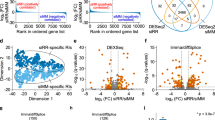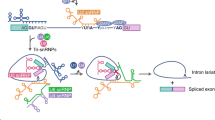Abstract
Alternative splicing modulates the expression of many oncogene and tumor-suppressor isoforms. We have tested whether some alternative splicing factors are involved in cancer. We found that the splicing factor SF2/ASF is upregulated in various human tumors, in part due to amplification of its gene, SFRS1. Moreover, slight overexpression of SF2/ASF is sufficient to transform immortal rodent fibroblasts, which form sarcomas in nude mice. We further show that SF2/ASF controls alternative splicing of the tumor suppressor BIN1 and the kinases MNK2 and S6K1. The resulting BIN1 isoforms lack tumor-suppressor activity; an isoform of MNK2 promotes MAP kinase–independent eIF4E phosphorylation; and an unusual oncogenic isoform of S6K1 recapitulates the transforming activity of SF2/ASF. Knockdown of either SF2/ASF or isoform-2 of S6K1 is sufficient to reverse transformation caused by the overexpression of SF2/ASF in vitro and in vivo. Thus, SF2/ASF can act as an oncoprotein and is a potential target for cancer therapy.
This is a preview of subscription content, access via your institution
Access options
Subscribe to this journal
Receive 12 print issues and online access
$189.00 per year
only $15.75 per issue
Buy this article
- Purchase on Springer Link
- Instant access to full article PDF
Prices may be subject to local taxes which are calculated during checkout








Similar content being viewed by others
References
Johnson, J.M. et al. Genome-wide survey of human alternative pre-mRNA splicing with exon junction microarrays. Science 302, 2141–2144 (2003).
Black, D.L. Mechanisms of alternative pre-messenger RNA splicing. Annu. Rev. Biochem. 72, 291–336 (2003).
Mayeda, A. & Krainer, A.R. Regulation of alternative pre-mRNA splicing by hnRNP A1 and splicing factor SF2. Cell 68, 365–375 (1992).
Cáceres, J.F., Stamm, S., Helfman, D.M. & Krainer, A.R. Regulation of alternative splicing in vivo by overexpression of antagonistic splicing factors. Science 265, 1706–1709 (1994).
Xu, Q. & Lee, C. Discovery of novel splice forms and functional analysis of cancer-specific alternative splicing in human expressed sequences. Nucleic Acids Res. 31, 5635–5643 (2003).
Wang, Z. et al. Computational analysis and experimental validation of tumor-associated alternative RNA splicing in human cancer. Cancer Res. 63, 655–657 (2003).
Venables, J.P. Aberrant and alternative splicing in cancer. Cancer Res. 64, 7647–7654 (2004).
Venkitaraman, A.R. Cancer susceptibility and the functions of BRCA1 and BRCA2. Cell 108, 171–182 (2002).
Hammes, A. et al. Two splice variants of the Wilms' tumor 1 gene have distinct functions during sex determination and nephron formation. Cell 106, 319–329 (2001).
Wu, J.Y., Tang, H. & Havlioglu, N. Alternative pre-mRNA splicing and regulation of programmed cell death. Prog. Mol. Subcell. Biol. 31, 153–185 (2003).
Ge, K. et al. Mechanism for elimination of a tumor suppressor: aberrant splicing of a brain-specific exon causes loss of function of Bin1 in melanoma. Proc. Natl. Acad. Sci. USA 96, 9689–9694 (1999).
Kumar, A., Baker, S.J., Lee, C.M. & Reddy, E.P. Molecular mechanisms associated with the regulation of apoptosis by the two alternatively spliced products of c-Myb. Mol. Cell. Biol. 23, 6631–6645 (2003).
Tennenbaum, T. et al. A splice variant of alpha 6 integrin is associated with malignant conversion in mouse skin tumorigenesis. Proc. Natl. Acad. Sci. USA 92, 7041–7045 (1995).
Steinman, H.A. et al. An alternative splice form of Mdm2 induces p53-independent cell growth and tumorigenesis. J. Biol. Chem. 279, 4877–4886 (2004).
Tockman, M.S. et al. Prospective detection of preclinical lung cancer: results from two studies of heterogeneous nuclear ribonucleoprotein A2/B1 overexpression. Clin. Cancer Res. 3, 2237–2246 (1997).
Ghigna, C., Moroni, M., Porta, C., Riva, S. & Biamonti, G. Altered expression of heterogenous nuclear ribonucleoproteins and SR factors in human colon adenocarcinomas. Cancer Res. 58, 5818–5824 (1998).
Patry, C. et al. Small interfering RNA-mediated reduction in heterogeneous nuclear ribonucleoparticule A1/A2 proteins induces apoptosis in human cancer cells but not in normal mortal cell lines. Cancer Res. 63, 7679–7688 (2003).
He, X., Ee, P.L., Coon, J.S. & Beck, W.T. Alternative splicing of the multidrug resistance protein 1/ATP binding cassette transporter subfamily gene in ovarian cancer creates functional splice variants and is associated with increased expression of the splicing factors PTB and SRp20. Clin. Cancer Res. 10, 4652–4660 (2004).
Fischer, D.C. et al. Expression of splicing factors in human ovarian cancer. Oncol. Rep. 11, 1085–1090 (2004).
Ghigna, C. et al. Cell motility is controlled by SF2/ASF through alternative splicing of the Ron protooncogene. Mol. Cell 20, 881–890 (2005).
Sinclair, C.S., Rowley, M., Naderi, A. & Couch, F.J. The 17q23 amplicon and breast cancer. Breast Cancer Res. Treat. 78, 313–322 (2003).
Cáceres, J.F., Screaton, G.R. & Krainer, A.R. A specific subset of SR proteins shuttles continuously between the nucleus and the cytoplasm. Genes Dev. 12, 55–66 (1998).
Sanford, J.R., Gray, N.K., Beckmann, K. & Cáceres, J.F. A novel role for shuttling SR proteins in mRNA translation. Genes Dev. 18, 755–768 (2004).
de Stanchina, E. et al. E1A signaling to p53 involves the p19(ARF) tumor suppressor. Genes Dev. 12, 2434–2442 (1998).
Huang, Y. & Steitz, J.A. SRprises along a messenger's journey. Mol. Cell 17, 613–615 (2005).
Mixon, M., Kittrell, F. & Medina, D. Expression of Brca1 and splice variant Brca1delta11 RNA levels in mouse mammary gland during normal development and tumorigenesis. Oncogene 19, 5237–5243 (2000).
Sakamuro, D., Elliott, K.J., Wechsler-Reya, R. & Prendergast, G.C. BIN1 is a novel MYC-interacting protein with features of a tumour suppressor. Nat. Genet. 14, 69–77 (1996).
Hanahan, D. & Weinberg, R.A. The hallmarks of cancer. Cell 100, 57–70 (2000).
Holz, M.K., Ballif, B.A., Gygi, S.P. & Blenis, J. mTOR and S6K1 mediate assembly of the translation preinitiation complex through dynamic protein interchange and ordered phosphorylation events. Cell 123, 569–580 (2005).
Waskiewicz, A.J. et al. Phosphorylation of the cap-binding protein eukaryotic translation initiation factor 4E by protein kinase Mnk1 in vivo. Mol. Cell. Biol. 19, 1871–1880 (1999).
Scheper, G.C. et al. The N and C termini of the splice variants of the human mitogen-activated protein kinase-interacting kinase Mnk2 determine activity and localization. Mol. Cell. Biol. 23, 5692–5705 (2003).
Harada, H., Andersen, J.S., Mann, M., Terada, N. & Korsmeyer, S.J. p70S6 kinase signals cell survival as well as growth, inactivating the pro-apoptotic molecule BAD. Proc. Natl. Acad. Sci. USA 98, 9666–9670 (2001).
Scheper, G.C., Morrice, N.A., Kleijn, M. & Proud, C.G. The mitogen-activated protein kinase signal-integrating kinase Mnk2 is a eukaryotic initiation factor 4E kinase with high levels of basal activity in mammalian cells. Mol. Cell. Biol. 21, 743–754 (2001).
Sjöblom, T. et al. The consensus coding sequences of human breast and colorectal cancers. Science 314, 268–274 (2006).
Kim, S., Shi, H., Lee, D.K. & Lis, J.T. Specific SR protein-dependent splicing substrates identified through genomic SELEX. Nucleic Acids Res. 31, 1955–1961 (2003).
Xu, X. et al. ASF/SF2-regulated CaMKIIdelta alternative splicing temporally reprograms excitation-contraction coupling in cardiac muscle. Cell 120, 59–72 (2005).
Wang, H.Y., Xu, X., Ding, J.H., Bermingham, J.R., Jr. & Fu, X.D. SC35 plays a role in T cell development and alternative splicing of CD45. Mol. Cell 7, 331–342 (2001).
Blanchette, M., Green, R.E., Brenner, S.E. & Rio, D.C. Global analysis of positive and negative pre-mRNA splicing regulators in Drosophila. Genes Dev. 19, 1306–1314 (2005).
Bjornsti, M.A. & Houghton, P.J. Lost in translation: dysregulation of cap-dependent translation and cancer. Cancer Cell 5, 519–523 (2004).
Topisirovic, I., Ruiz-Gutierrez, M. & Borden, K.L. Phosphorylation of the eukaryotic translation initiation factor eIF4E contributes to its transformation and mRNA transport activities. Cancer Res. 64, 8639–8642 (2004).
Schalm, S.S. & Blenis, J. Identification of a conserved motif required for mTOR signaling. Curr. Biol. 12, 632–639 (2002).
Hanks, S.K. & Hunter, T. Protein kinases 6. The eukaryotic protein kinase superfamily: kinase (catalytic) domain structure and classification. FASEB J. 9, 576–596 (1995).
Zender, L. et al. Identification and validation of oncogenes in liver cancer using an integrative oncogenomic approach. Cell 125, 1253–1267 (2006).
Kim, M. et al. Comparative oncogenomics identifies NEDD9 as a melanoma metastasis gene. Cell 125, 1269–1281 (2006).
DuHadaway, J.B., Sakamuro, D., Ewert, D.L. & Prendergast, G.C. Bin1 mediates apoptosis by c-Myc in transformed primary cells. Cancer Res. 61, 3151–3156 (2001).
Bourgeois, C.F., Lejeune, F. & Stévenin, J. Broad specificity of SR (serine/arginine) proteins in the regulation of alternative splicing of pre-messenger RNA. Prog. Nucleic Acid Res. Mol. Biol. 78, 37–88 (2004).
Li, X. & Manley, J.L. Inactivation of the SR protein splicing factor ASF/SF2 results in genomic instability. Cell 122, 365–378 (2005).
McCurrach, M.E. & Lowe, S.W. Methods for studying pro- and antiapoptotic genes in nonimmortal cells. Methods Cell Biol. 66, 197–227 (2001).
Stolarov, J. et al. Design of a retroviral-mediated ecdysone-inducible system and its application to the expression profiling of the PTEN tumor suppressor. Proc. Natl. Acad. Sci. USA 98, 13043–13048 (2001).
Karni, R., Jove, R. & Levitzki, A. Inhibition of pp60c-Src reduces Bcl-XL expression and reverses the transformed phenotype of cells overexpressing EGF and HER-2 receptors. Oncogene 18, 4654–4662 (1999).
Acknowledgements
We thank G. Dreyfuss (University of Pennsylvania) for antibodies to hnRNP A1 and A2; D. Pant for advice on statistical tests; A. Rosenberg, M. Nolan and S. Muthuswamy (Cold Spring Harbor Laboratory) for the breast-cancer cell lines; and M. Hemann, L. Zender, R.-M. Xu, A. Neuwald, S. Powers and R. Lucito for helpful discussions. This work was supported by grant CA13106 from the US National Cancer Institute.
Author information
Authors and Affiliations
Corresponding author
Ethics declarations
Competing interests
The authors declare no competing financial interests.
Supplementary information
Supplementary Fig. 1
Amplification and overexpression of SF2/ASF in cancer cell lines, and correlation with alternative splicing of its targets. (PDF 667 kb)
Supplementary Fig. 2
Analysis of transduced splicing factor levels in mouse, rat and human cell lines. (PDF 652 kb)
Supplementary Fig. 3
Alternative splicing of mouse Rps6kb1 and primary structure of the two S6K1 isoforms. (PDF 29 kb)
Supplementary Fig. 4
Correlation between SF2/ASF expression and S6K1 isoform ratios in 50 lung tumors. (PDF 84 kb)
Supplementary Fig. 5
Knockdown of isoform-2 of S6K1 reverses NCI-H460 cell transformation. (PDF 355 kb)
Supplementary Table 1
Alternative splicing changes induced by overexpression or knockdown of specific splicing factors. (PDF 116 kb)
Supplementary Table 2
Primers, probes and shRNA templates. (PDF 133 kb)
Rights and permissions
About this article
Cite this article
Karni, R., de Stanchina, E., Lowe, S. et al. The gene encoding the splicing factor SF2/ASF is a proto-oncogene. Nat Struct Mol Biol 14, 185–193 (2007). https://doi.org/10.1038/nsmb1209
Received:
Accepted:
Published:
Issue Date:
DOI: https://doi.org/10.1038/nsmb1209
This article is cited by
-
Role of epithelial splicing regulatory protein 1 in cancer progression
Cancer Cell International (2023)
-
RNA splicing dysregulation and the hallmarks of cancer
Nature Reviews Cancer (2023)
-
Posttranslational splicing modifications as a key mechanism in cytarabine resistance in acute myeloid leukemia
Leukemia (2023)
-
Phosphorylation of IWS1 by AKT maintains liposarcoma tumor heterogeneity through preservation of cancer stem cell phenotypes and mesenchymal-epithelial plasticity
Oncogenesis (2023)
-
Splicing factor SRSF1 deficiency in the liver triggers NASH-like pathology and cell death
Nature Communications (2023)



